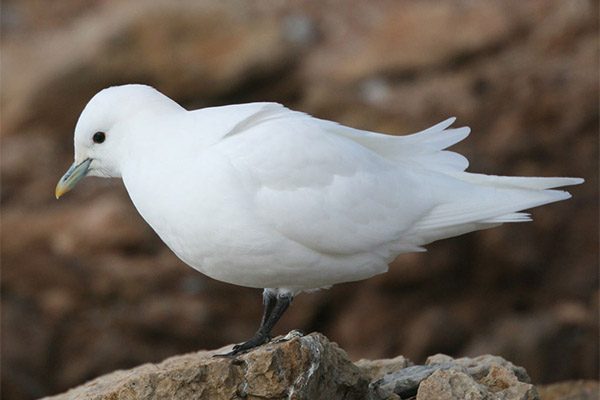The content of the article
The Latin name of the bird is the white gull - Pagophila eburnea. This species belongs to the gull family.
Description
This is a white bird of medium size. A little more than a gray representative of the family. She has a round head, her legs and neck are short. The shape of the body makes it look a bit like a dove. Length - 40-47 cm, weight - about 450 g. It can reach up to 700 g. Wingspan - 105-120 cm.
Adult plumage gets to the age of two. In any season, bird plumage has a white color, with a touch of ivory. The beak is gray with a greenish or blue tint. The tip of the beak has a yellow or orange tint. Sometimes there are individuals with a completely yellow beak. Unlike other types of gulls, they have black paws.
Plumage nesting outfit as well as the first winter, white. On some parts of the body there are blackish mottled. Before the eyes and in the throat area there are spots of brown and black. Plumage under wing white.
White gulls have a unique appearance, so that they can not be confused with any other bird. Types of burgomaster, as well as the polar gull are much larger. Representatives of these species in the first year may also be almost white. But the proportions of the body significantly distinguish them from white gulls. They have more beaks, and their legs have a pinkish tint. The albino seagull is also very similar in appearance to white. But they can be distinguished by a two-color beak, as well as on the legs, which are short and black in a white gull.
Vote
Usually silent. From time to time it may emit a crackling sound, similar to the cry of the Arctic tern.
Habitat
Representatives of the species live near the North Pole. Their habitats depend on the state of the ice. When they do not nest, they can usually be in the area of drifting ice. In these places they are looking for food for themselves. In winter, these birds migrate south.
Lifestyle and reproduction
These birds nest in colonies. To do this, they choose hard-to-reach places. Nests are located on the islands, as far as possible from the coast. But there are cases when they equip the nest quite close to people. Polar station workers claim that seagulls sometimes nest right next to them. Breeding success depends on the weather conditions in the area.
If during the summer the ice never leaves the surface of the reservoirs, the white gull may not even begin laying eggs. The scientists who watched them noticed that in this case the birds simply sat on the nest, as if hatching eggs. The crucial point for them is the ability to get food during the nesting period. At the age of 2-3 years, individuals reach sexual maturity. The young constantly live in the middle of the ice.
The white gull is the only species that remains throughout the year in the ocean.
They fly very fast and can also run on the surface of the earth. White plumage makes them invisible against the background of snow and the northern sky. They feed on fish thrown on the shore, because they do not know how to dive.For food unpretentious. They can eat lemmings, invertebrates and even chicks of other birds. In the summer, they eat the waste of whaling. In winter, polar bears can be followed to eat the remains of their food. Sometimes, after a storm on the shore, there is a huge amount of ration that many birds eat.
During a strong blizzard, they hide in shelter. Scientists suggest that for some time, seagulls may fall into a stupor, thanks to which they are able to survive without food.
Since the summer in these latitudes is extremely short, the reproduction of birds is fast. In July, they lay 1-2 eggs. In August, there are chicks that can fly in a month.
These birds protect their nests from predator attacks. As soon as they see that the enemy is approaching, the birds pounce on him from all sides. They peck at him and beat him with wings. The enemy has no choice but to leave the nesting site. And even after that the seagulls pursue him. When they are sure that they have driven the predator away, they calm down and return to their nests.
To date, a decrease in the number of these birds. This is due to climate change.It is getting warmer on the territory of the Arctic, the glaciation area is decreasing every year. This means that the birds have less space where they could nest. This is one of the reasons why the species is becoming less and less - they need protection.
Video: white seagull (Pagophila eburnea)












To send